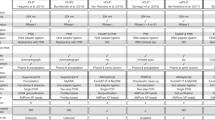Abstract
UV cross-linking and immunoprecipitation coupled to high-throughput sequencing (CLIP-seq) is used to characterize RNA targets of RNA binding proteins (RBP) in a large scale manner. This powerful method allows the stringent purification of direct RNA binding sites of RBPs in living cells. Here, we describe in detail the protocol we employed to identify RNA targets of the human RNA helicase eIF4AIII.
Access this chapter
Tax calculation will be finalised at checkout
Purchases are for personal use only
Similar content being viewed by others
References
Lee SR, Lykke-Andersen J (2013) Emerging roles for ribonucleoprotein modification and remodeling in controlling RNA fate. Trends Cell Biol 23:504–510
Moore MJ, Proudfoot NJ (2009) Pre-mRNA processing reaches back to transcription and ahead to translation. Cell 136:688–700
Le Hir H, Izaurralde E, Maquat LE, Moore MJ (2000) The spliceosome deposits multiple proteins 20-24 nucleotides upstream of mRNA exon-exon junctions. EMBO J 19:6860–6869
Tange TO, Nott A, Moore MJ (2004) The ever-increasing complexities of the exon junction complex. Curr Opin Cell Biol 16:279–284
Andersen CB, Ballut L, Johansen JS, Chamieh H, Nielsen KH, Oliveira CL, Pedersen JS, Seraphin B, Le Hir H, Andersen GR (2006)Structure of the exon junction core complex with a trapped DEAD-box ATPase bound to RNA. Science 313:1968–1972
Le Hir H, Andersen GR (2008) Structural insights into the exon junction complex. Curr Opin Struct Biol 18:112–119
Ashton-Beaucage D, Udell CM, Lavoie H, Baril C, Lefrancois M, Chagnon P, Gendron P, Caron-Lizotte O, Bonneil E, Thibault P, Therrien M (2010) The exon junction complex controls the splicing of MAPK and other long intron-containing transcripts in Drosophila. Cell 143:251–262
Chazal PE, Daguenet E, Wendling C, Ulryck N, Tomasetto C, Sargueil B, Le Hir H (2013) EJC core component MLN51 interacts with eIF3 and activates translation. Proc Natl Acad Sci U S A 110:5903–5908
Le Hir H, Gatfield D, Izaurralde E, Moore MJ (2001) The exon-exon junction complex provides a binding platform for factors involved in mRNA export and nonsense-mediated mRNA decay. EMBO J 20:4987–4997
Roignant JY, Treisman JE (2010) Exon junction complex subunits are required to splice Drosophila MAP kinase, a large heterochromatic gene. Cell 143:238–250
Sauliere J, Murigneux V, Wang Z, Marquenet E, Barbosa I, Le Tonqueze O, Audic Y, Paillard L, Roest Crollius H, Le Hir H (2012) CLIP-seq of eIF4AIII reveals transcriptome-wide map** of the human exon junction complex. Nat Struct Mol Biol 19:1124–1131
Ule J, Jensen K, Mele A, Darnell RB (2005) CLIP: a method for identifying protein-RNA interaction sites in living cells. Methods 37:376–386
Ule J, Jensen KB, Ruggiu M, Mele A, Ule A, Darnell RB (2003) CLIP identifies Nova-regulated RNA networks in the brain. Science 302:1212–1215
Darnell RB (2010) HITS-CLIP: panoramic views of protein-RNA regulation in living cells. Wiley Interdiscip Rev RNA 1:266–286
Licatalosi DD, Mele A, Fak JJ, Ule J, Kayikci M, Chi SW, Clark TA, Schweitzer AC, Blume JE, Wang X, Darnell JC, Darnell RB (2008)HITS-CLIP yields genome-wide insights into brain alternative RNA processing. Nature 456:464–469
Author information
Authors and Affiliations
Corresponding author
Editor information
Editors and Affiliations
Rights and permissions
Copyright information
© 2015 Springer Science+Business Media New York
About this protocol
Cite this protocol
Saulière, J., Le Hir, H. (2015). CLIP-Seq to Discover Transcriptome-Wide Imprinting of RNA Binding Proteins in Living Cells. In: Rederstorff, M. (eds) Small Non-Coding RNAs. Methods in Molecular Biology, vol 1296. Humana Press, New York, NY. https://doi.org/10.1007/978-1-4939-2547-6_14
Download citation
DOI: https://doi.org/10.1007/978-1-4939-2547-6_14
Publisher Name: Humana Press, New York, NY
Print ISBN: 978-1-4939-2546-9
Online ISBN: 978-1-4939-2547-6
eBook Packages: Springer Protocols




